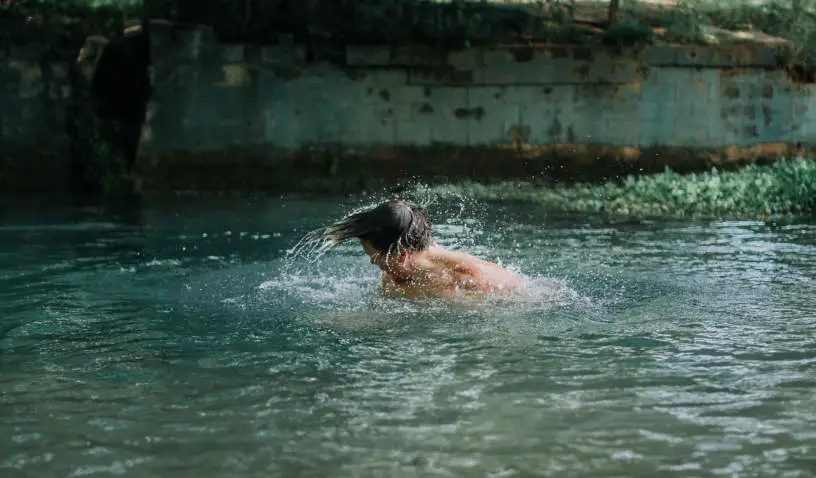Nymphs from Greek mythology are known as beautiful female nature spirits who live in and watch over certain places in nature like oceans, rivers and trees. But can a nymph be male as well?
Nymphs are inferior deities in Greek mythology that are exclusively female.
There are no male nymphs but there three male counterparts to the female nymphs: these male nature spirits and gods include the Satyrs from woodlands, the Tritons from the sea and the Potamoi from rivers.
Even though nymphs and these male nature spirits have some similarities they are definitely different creatures, especially when it comes to their looks and behavior.
What are the male versions of nymphs?
As mentioned, there are no male nymphs. But the Satyrs, Potamoi and Tritons can be called male nymph equivalents. They are the closest male equivalents to the nymphs because they are inferior nature spirits and nature gods that are strongly tied to certain locations in nature, just like the nymphs.
Many nymphs are actually thought to live in one specific tree, meadow, river, etc. The same can be said for their male counterparts, especially the Potamoi (river gods).
Something that differentiates the male versions from most nymphs (most of them look like humans) is the fact that they often are half-animal or at least have some animal parts.
There are many different types of nymphs. You can broadly categorize them into celestial, land, tree, sea, water and underworld nymphs.
In the following table, you can see which specific nymphs have a male counterpart.
| Types of Nymphs (all female) | Male nymph counterparts |
| Celestial nymphs | – |
| Land nymphs (mountains, grottos, meadows) | Satyrs |
| Wood, tree and plant nymphs | Satyrs |
| Water nymphs | Potamoi |
| Sea nymphs | Tritons |
| Underworld nymphs | – |
The counterpart of the land and tree nymphs are the Satyrs.
They have the ears and a tail of a horse and were often depicted with a permanent erection.
A specific type of Satyr, that is often used today to represent Satyrs, is the Panes, which have the legs and lower body of a goat.
The Potamoi are the counterparts to the water nymphs, to be specific the Oceanids.
The Ocanids were the 3000 daughters of the river god Oceanus and the goddess Thetis. They also had the same amount of sons, which were called the Potamoi (river gods) because they represented all the rivers.
The Potamoi were either depicted as men or with body parts of a bull or with a serpentlike fishtail.
Lastly, there are the Tritons. They can be seen as the male versions of the sea nymphs, the Nereids.
These ocean deities were the sons of the ocean god Triton, who is one of the gods in Greek mythology that had a fishtail.
Just like their father, the Tritons are usually depicted as mermen with tails.
The Satyrs as the male counterpart to the land and tree nymphs
Satyrs were male nature spirits that were known for their wild and often questionable behavior.
They mostly lived in woodlands, mountains and pastures where the land and tree nymphs lived as well. But they did not have the same powers as the nymphs who watched over their trees etc.
Instead, the satyrs were much more animalistic. They were often trying to seduce or abduct nymphs (mostly without success).
By the way, that is why in the 18th century the term satyriasis (for male sexual addiction) was coined as the counterpart for the word nymphomania (for female sexual addiction).
Sometimes they were living together peacefully too though. The satyrs were particularly often depicted with tree nymphs (Dryads).
Other than that, the satyrs were also often accompanying the wine god Dionysus. They loved to drink, dance and play music.
Because of their exaggerated and obscene humor they also inspired a new form of theatre performance in ancient Greece: the “stayr play” (If you are wondering, the word “satire” did not derive from this word apparently.).
There a few specific types of satyrs. In the following table, you can see them.
| Types of satyrs | Appearance |
| Pans (fauns) | Satyrs with goat legs and horns |
| Silens | Elderly satyrs |
| Satyrisci | Child satyrs |
| Tityroi | Satyrs who play the flute |
The panes, the goat-legged satyrs, are probably the most famous form of satyr, because that’s how they were most often depicted since the Renaissance.
Today they are mostly called fauns though, which is their roman name.

The fauns we know today actually don’t behave like the wild ancient satyrs anymore.
Since the beginning of the 20th century, they were introduced in fantasy and children’s literature and thus lost all the bad characteristics.
That’s why the Faun in the Narnia Chronicles – Mr. Tumnus – is such a nice and friendly woodland dweller.
The Potamoi as the male counterpart to the water nymphs
The Potamoi were river gods of the 3000 rivers and were either depicted as a man with a pitcher which is pouring water, as part bull or as part fish/serpent.
They were the male versions of their water nymph sisters, the Oceanids, who were the goddesses of small streams, clouds and rain.
Just like the Oceanids, the Potamoi watched over their own rivers and had special natural powers.
In the following picture, you can see the Potamoi Ladon in the front of the picture with his pitcher from which the water is running.

The girl in the picture is his daughter and he is the midst of turning her into a laurel bush to help her hide from Apollo who was cursed with a love spell by Cupid and therefore running after her.
The daughters of the Potamoi are called Naiads and are water nymphs that are associated with springs, fountains, streams, brooks and other bodies of fresh water.
So the Potamoi can be described as the male version of both the Oceanids and Naiads (both water nymphs).
In their half-human half-animal forms they usually had one big horn.
In the following picture, you can see what the half-fish types of Potamoi looked like.

The Potamoi that is shown here is Achelous. Heracles (his Roman name is Hercules) was fighting him for the right to marry the princess Deianira and lastly beat him.
The Tritons as the male counterpart to the sea nymphs
The Tritons were sometimes called the satyrs of the sea (sometimes “sea-Pan” or “sea-satyr”).
They were the plurification of the ocean god Triton, as if they were his sons, and were also depicted with a fishtail as Triton very often was.
The word Tritons actually came to mean the same as mermen over time.
Triton’s mother Amphitrite was a Nereid, a sea nymph, and his father was Poseidon, the god of the sea. So it only made sense that Triton had an extra-strong connection to the sea, like his fishtail shows.
The Nereids were also sometimes depicted with fish-tails, but not as often as the Tritons. The Tritons also had lesser-known sisters which were called the Tritonides.
So you could say that the Tritons were the male versions of the Nereids and Tritonides (both sea nymphs).
Just like the sea nymphs they lived in the sea. There they mostly followed Poseidon and supported him in his quests.

In the picture, you can see a depiction of one of the Tritons on the Trevi Fountain in Rome.


Sensational
Who knew